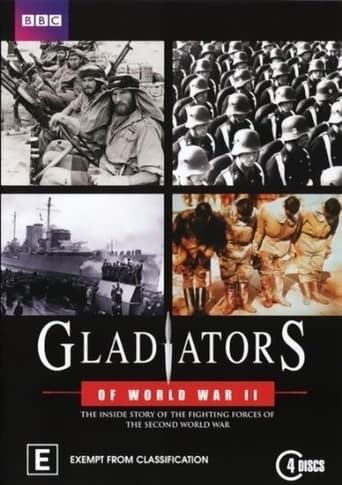Gladiators of World War II (2002)
Gladiators of World War II
2002
In this BBC documentary series newly declassified documents are used to examine the strategic roles played in the war by thirteen of the world's regular and resistance land, sea and air forces.
Seasons & Episode

Originally created as Hitler's personal household troops, the Waffen-SS grew into a formidable fighting force during World War 2. It gained a reputation second to none for its tenacity in combat, but also for brutality, which made it the subject of numerous Allied war crimes investigations.

In the dark days of summer 1940 Winston Churchill set up the Special Operations Executive to "set Europe ablaze". Its task was to nurture and support the resistance movements springing up across Occupied Europe. It also operated in the Middle and Far East. The brave men and women of SOE operated under constant threat to their lives, but were responsible for some remarkably successful blows against the Axis enemy.

The men of the British Armoured Division gained the nickname Desert Rats during their epic campaign against the Axis forces under Erwin Rommel in the deserts of Egypt and Libya. Thereafter, the Desert Rats fought with great distinction in Sicily, Italy and North-West Europe. Their long road took them from the Suez Canal to the Nazi capital of Berlin.

The German overrunning of their country in 1939 did not crush the Polish spirit. Many escaped to the West to carry on the fight. Polish fighter pilots played a major role in the Battle of Britain, while Polish ground forces helped to liberate Western Europe. Another Polish force, held captive by the Russians in Siberia, made an epic trek to the Middle East to fought in Italy, where their courage brought a victorious end to the bitter battle for Monte Cassino.

It was the Few of RAF Fighter Command who saved Britain from almost certain defeat in summer 1940. The unique spirit generated by its fighter pilots enabled the Command to overcome the might of the Luftwaffe and to continue to wage a relentless campaign which finally ended in ultimate victory in May 1945.

Winston Churchill created the Commandos in summer 1940 as a means of striking at the coasts of Nazi Occupied Europe. Beginning as a mere raiding force, they became the spearhead of the Allied amphibious landings in North Africa, Sicily, Italy, and Normandy. Out of the Commandos evolved Britain's airborne forces, whose feats ranged from the daring Bruneval raid of 1942 to the epic of Arnhem.

Norway was strategically important to Hitler and endured five years of Nazi occupation, but it developed one of the most effective resistance movements in the whole of Occupied Europe. Its activities helped the British to contain and then destroy Germany's mightiest warships, as well as to ensure that the Allies won the race to develop the atomic bomb.

Born of one man's vision at a time when the Japanese seemed to be sweeping all before them, the Chindits proved an inspiration to the Allied forces in Burma. They showed that it was not only possible to live in the jungle for months on end but also that Western troops could defeat the Japanese.

In June 1940, with France about to collapse, General Charles de Gaulle unfurled his Free French banner in London. His followers were initially few and were regarded as traitors by many of their fellow countrymen, but they grew in number. Free French forces fought with distinction in North Africa and Italy and went on to play a significant part in the liberation of their own country.
In this BBC documentary series newly declassified documents are used to examine the strategic roles played in the war by thirteen of the world's regular and resistance land, sea and air forces.
Watch Trailer
Free Trial Channels























